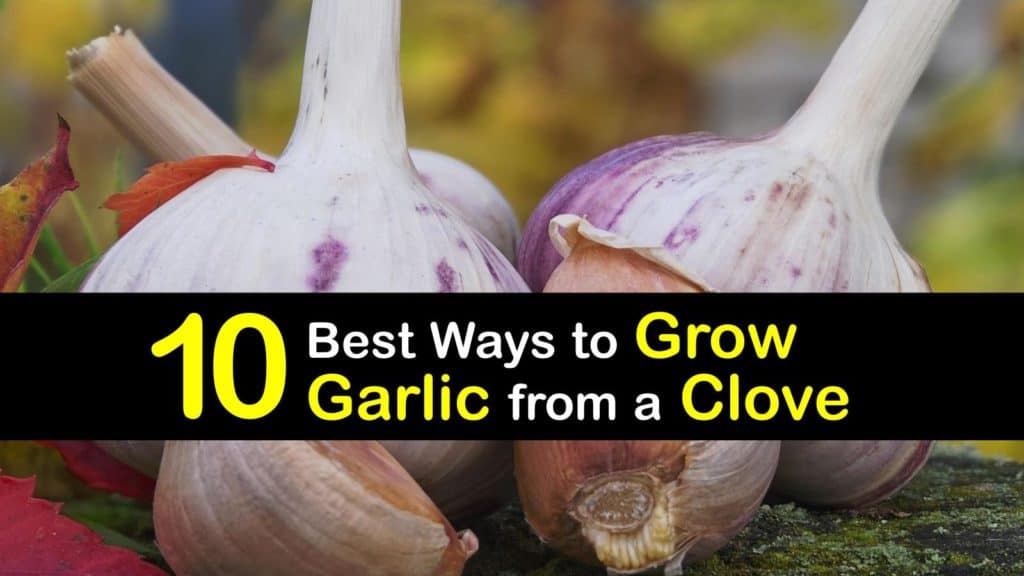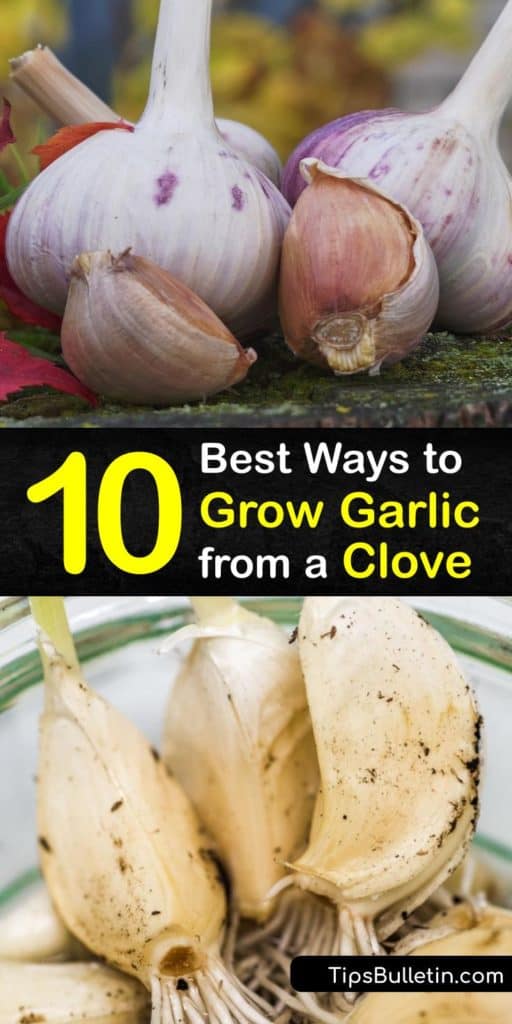Most garlic-lovers agree that there is no such thing as too much garlic. There are so many culinary uses for this bulb of the allium family, and its intense flavor adds the perfect touch to everything from marinades and pesto to soups and stews. We’ll show you how to grow garlic from a clove, so you never need to buy it from the grocery store again.
Have you ever reached into your fridge for a clove of grocery store garlic and discovered these bulbs are sprouting? While they are perfectly safe to eat, they are sharp and bitter.
But, don’t throw the garlic bulbs in the garbage just yet. The individual cloves of the bulb are useful for planting garlic to grow a new bulb.
Garlic is one of the most uncomplicated crops to grow. Not only that, but developing new plants from the scraps of store garlic is a task so simple that beginning growers don’t have to worry about failing.

- Ways to Grow, Maintain, and Harvest Garlic from Cloves
- Can You Regrow Garlic?
- Growing Garlic from Cloves
- How to Grow Garlic from a Clove in the Garden
- Growing Garlic Cloves in a Container Garden
- Growing Garlic Greens Indoors
- How to Maintain and Care for Garden Garlic
- Common Problems When Growing Garlic
- Garlic Pests and How to Get Rid of Them
- When and How to Harvest Garlic
- How to Cure and Store Garlic Cloves after Harvesting
Ways to Grow, Maintain, and Harvest Garlic from Cloves
While many plants grow from seeds, some regrow in other astonishing ways. The bits you toss into the garbage or compost are more useful than you think.
These leftover scraps often grow new plants, and this is true for garlic. You can also regrow ginger from a piece of root. We’ll show you how to choose the right types of garlic, explain the growing season, and how to grow, maintain, and harvest your plants.
Can You Regrow Garlic?
Not all fruits and vegetables grow solely from seeds. Some, including garlic, grow back from different parts of the produce.
It’s surprisingly easy to regrow garlic, but it’s important to know which ones to grow in your location and the proper time for planting before proceeding.
Garlic Bulbs
Garlic (Allium sativum) is an allium closely related to onions, chives, and shallots, and there are many garlic varieties. These range from organic garlic to elephant garlic, which is more similar to leeks.
Softneck garlic is most widely available and grows well in USDA hardiness zones 5 and up. Hardneck varieties have large cloves, produce scapes, green shoots, bulbils, and garlic seed, and grow best in warmer climates.

Planting and harvesting garlic has a different time period than other crops. While you plant most veggies and fruit seeds in the early spring and harvest them in the fall, you plant garlic in the fall or early spring and harvest it in July, depending on your climate and the garlic seed stock.
Growing Garlic from Cloves
There are many questions when growing garlic from cloves, such as how deep to plant garlic cloves, how many cloves are in a bulb of garlic, how to prepare them for planting, and where is the ideal place to grow them. We’ll answer these questions, and more, to help you grow the tastiest garlic.
Growing Garlic
The first step when deciding to grow garlic is to determine the type of climate you live in. Softneck varieties are great for growing in colder regions, and if you live in a warm area, consider growing hardneck garlic.
The next step is to choose the correct spot of your yard or patio to plant garlic. These plants require full sun so choose an area that gets as much daily sunshine as possible.
Use soil with good drainage and add compost or manure if it lacks nutrients. The cloves are pressed two inches below the soil surface and require eight-inch spacing, so make sure your area is suitable in size.
When you’re ready for planting, choose healthy, fresh garlic with large cloves. While it’s okay to plant cloves with sprouts, avoid them if they are soft, mushy, or discolored.
How to Grow Garlic from a Clove in the Garden
Growing your own veggies in the backyard is one of the most satisfying experiences, and harvesting garlic bulbs at the end of the growing season keeps your kitchen fully stocked with flavor. Here is how to plant garlic from cloves in a garden bed.
Begin by breaking the cloves away from the head of garlic, making sure not to damage their base. Make a two-inch hole in the soil and place the clove, tip side up, in the space.
Cover it with dirt and pack it lightly before giving it a good drink of water. To plant more cloves, repeat the process by spacing them about eight inches apart and cover the area with mulch.
Growing Garlic Cloves in a Container Garden
Growing garlic from cloves in a garden is the most common method. However, it’s just as simple to grow them in raised beds or grow garlic in a container garden if you do not have space.
When growing garlic in a pot, fill a decent-sized container with a good potting mix and place a garlic clove two-inches deep into the center of the dirt with the pointed end up. Cover it with more soil and pack it down lightly.
Sprinkle mulch, hay, or dry leaves over the top to prevent the dirt from drying out and give it a good watering to help it settle.
Set the pot in a sunny location on your patio or porch and water it once weekly to keep it moist, and then reduce watering once the season warms up.
Follow a similar procedure to grow ginger roots at home, whether indoors or out. You may be surprised at how prolific home-grown produce is.
Growing Garlic Greens Indoors
If you do not have a patio or yard and want the enjoyment of growing garlic greens, it’s nearly effortless to regrow garlic indoors. These greens have a mild flavor and taste great in any dish that calls for garlic or green onions.
Choose a planting container or pot that is at least eight inches deep and twelve inches wide, and make sure that there are drainage holes in the bottom.
Fill the container with potting soil and press each garlic clove, flat side down, into the dirt until it is one to two inches deep. Space each clove five inches from each other, pack them lightly with dirt and water them thoroughly to help them settle.
Set the pot in a south or west-facing window where it gets the most sunshine and fertilize the garlic every three weeks with a liquid fertilizer.
Keep the medium damp but not soaked as the garlic greens grow, and harvest them regularly once they reach six inches tall.
How to Maintain and Care for Garden Garlic
Now that you have your garlic cloves seated in the soil, there are a few steps to take to ensure they grow healthy and reward you with the best garlic bulbs. Here is how to care for your plants for optimal growth.
It’s important to keep the roots moist while garlic grows, so water it weekly as needed when there is no rainfall.
Garlic requires a dry, hot summer to mature, so water it less frequently as the temperatures rise. Use fertilizer in the spring for fall planting and in the fall for spring planting.
Common Problems When Growing Garlic
While giving plants the right amount of sunshine and water seems like all that’s required for a healthy plant, there are things to watch for during the growing process. Here are some common problems to be aware of and how to rectify them.
Garlic Plant Problems
Over and under watering are common problems for garlic bulbs. They do not grow well if they receive too much water during cold months as the ground freezes.
White rot is another problem. This common garlic disease infects the plant, causing it to yellow, wilt, and die back. This is a soil fungus, and strict sanitation eliminates the problem.
Garlic Pests and How to Get Rid of Them
Insects and pests are a gardener’s worst enemy, and dealing with them in your plants is often an ongoing battle. Here are some pests that cause havoc to garlic plants and ways to deal with them.
Aphids love garlic leaves and flower buds, and these tiny insects are often hard to see until the damage is done. They hide on the leaves’ underside and are easy to kill by squashing them with your fingers or a paper towel.
Another garden pest that destroys garlic is mice. These rodents often nest in mulch and other debris and inhibit garlic growth. If you notice small burrows around your garden, consider using landscaping fabric or plastic mulch instead.
When and How to Harvest Garlic
After planting your garlic cloves, giving them TLC, and halting disease and pests, you await the time when they are ready for harvesting. There are several indicators that they are ready and easy ways to move them from the soil to the table.
Harvesting Garlic
Inspect the garlic leaves to help determine if the bulbs are ready for harvesting. If the leaves are yellow and brown, reach down beneath the dirt and touch the bulb to feel individual cloves.
If they pass these two tests, it’s time to harvest them. Use a fork or spoon to dig and pry the bulbs gently out of the ground and then cure them for two weeks. Do not harvest them if the leaves are still bright green.
How to Cure and Store Garlic Cloves after Harvesting
Now that you have a basketful of freshly harvested garlic bulbs, it’s time to cure and preserve garlic cloves for savory dishes. There are a few ways to go about this, and they are all helpful for garlic storage.
Before storing your garlic, it’s important to cure them. Do this by leaving the stems and roots in place. Tie a bunch of bulbs together with a string and hang them upside-down in a dark, cool place for about two weeks.
After curing them, store them in a garlic keeper and pull the cloves off as needed. Garlic is also useful for preserving in olive oil or vinegar and storing in the refrigerator to extend its shelf life.
The best way to enjoy fresh garlic is to plant cloves with or without sprouts rather than toss them in the trash.
Each clove produces a bulb of five to ten fresh cloves. Not only that, but garlic scapes and bulbils are edible and tasty added to any recipes that call for garlic.

Now that you learned how to grow garlic from a clove so that you don’t waste the sprouting sections, why not impress your family and friends on Facebook and Pinterest by sharing our garlic regrowing guide with them?